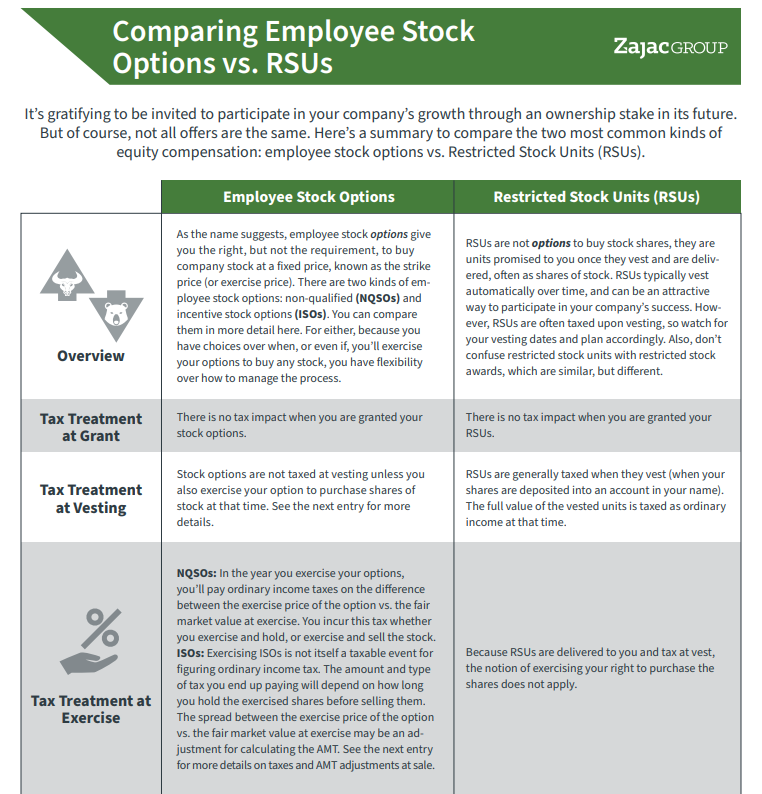
- A cash exercise, or
- A cashless exercise
This is not an exhaustive list of options. You may run across other terms such as sell-to-cover, same-day sale, or share withholding. While some of these terms are interchangeable and result in a similar outcome, you should check your plan details prior to implementing any specific exercise strategy.
Knowing your options may be easy. Evaluating whether to employ a cash vs. cashless exercise of your employee stock options may be more difficult.
For starters, the math behind what happens during a cash or a cashless exercise be tricky. And your decision to exercise will likely impact your cash flow, your investment risk profile, and how many shares of stock you will hold after the exercise of your employee stock options is complete.
If you find yourself holding employee stock options, you should know what a cash exercise and a cashless exercise are. You should also educate yourself on the details of a sell to cover, a same-day sale, and a share withholding. Each one has its own advantages and disadvantages to consider.
It’s possible that a large portion of your net worth is tied up in company stock options, so you owe it to yourself to evaluate and execute a strategy that maximizes your value (within your stated goals).
COMPARISON GUIDE
Not All Stock Offers are the Same! Here's a helpful comparison between two of the most common employee stock options.
Option 1 – A Cash Exercise
If your goal is to own as many shares of the employee stock as possible post-exercise, a cash exercise may be the best option. The process of a cash exercise may entail the following:
- You buy shares of company stock at the exercise price of your employee stock options.
- The price you pay for your shares is the exercise price of the stock option multiplied by the number of options you exercise.
- Because this is a cash exercise, you often need to pay an amount of cash equal to number 2 above. This is an out-of-pocket cost that you will need to have readily available. It’s possible, subject to the type of stock option that you exercise, that you may need to include the value of the projected tax owed on the exercise in the cash required to exercise.
Depending on the number of vested options you can exercise and the strike price at which you can exercise them, the out-of-pocket cost of a cash exercise can be a big number.
Unfortunately, it’s not uncommon to not have the necessary cash available to fund a cash exercise, or a preference to not use cash to pay for the exercise. For this reason, many find themselves “priced out” of a cash exercise, forcing them into a cashless exercise.
If you are one of those with cash on hand, here are a few things to know before you do a cash exercise:
- All else being equal, a cash exercise often maximizes the total amount of shares owned outright post-exercise, as compared to the other exercise strategies.
- The shares you exercise and hold may lead to a concentrated position of company stock that encompasses a large percentage of your net worth. Concentrated stock positions are something that should be continually evaluated for their pros and cons.
- If you have incentive stock options, a cash exercise may increase the likelihood that you will be subject to the alternative minimum tax.
- A cash exercise often requires the use of cash on hand, or the liquidation of other assets to pay the up-front cost of buying the shares.
Typically, those who choose a cash exercise are optimistic that the value of the company stock will go up. Therefore, they plan to hold the company stock in the medium- and long term. By holding company stock, you expose your portfolio to both the upside and downside risk of the markets.
Generally speaking, if the stock price goes up, you win. If the stock price goes down, you lose.
Option 2 – Cashless Exercise
If the goal is to retain no shares or some shares post-exercise, but not all shares, then some sort of a cashless exercise may be a good alternative strategy. A cashless exercise is often the default option if you don’t have the cash to pay the cost readily available.
A few highlights of a cashless exercise:
- You buy shares of the company stock via the employee stock option at the exercise price of the stock option grant.
- The price you pay for your shares is the exercise price multiplied by the number of options you wish to exercise.
- You will need to pay for the shares of stock. Instead of “writing a check” for the shares as you do with a cash exercise, you may be able to pay for your shares of stock with other shares of stock. To pay for the stock,
- You’ll immediately exercise and sell some (or all) of your shares. It’s possible that you will exercise and hold others.
- The amount you exercise and sell will be dependent on several factors, including the exercise price, the current stock price of your company stock, how many shares you want to own post-exercise, and your other personal financial goals and objectives.
A cashless exercise can be designed to cover only the exercise cost of the shares for which you need to purchase, the tax liability you will incur on the exercise of your shares, or both. The choice of how many shares you wish to buy and hold and how many shares to buy and sell might depend on the exercise price of your option and the current fair market price of the stock.
Now that you understand some of those details, let’s take a moment to understand what this all means:
- A cashless exercise is precisely what it sounds like – you do not use any cash to exercise your stock options. You use a portion of the value of your stock options to exercise some or all of the others.
- A cashless exercise may not maximize or minimize the number of shares you own outright. With a sell-to-cover cashless exercise, you can plan to end up “somewhere in the middle.”
- You may still own a concentrated position in the company’s stock, but it will not be as concentrated as it would be had you performed a cash exercise.
- If you have incentive stock options, then a cashless exercise may still lead to the alternative minimum tax, but that tax may be lower than that of a cash exercise.
What Next with a Cash or a Cashless Exercise
In a simple form, the decision on whether to do a cash or a cash exercise may boil down to whether or not you have enough cash on hand to cover the cost of an exercise and hold?
If you said yes, then ask this follow-up question: Do you want to use that cash to buy and hold shares of company stock?
If the answer is “yes” again, a cash exercise may be a strategy to maximize your company stock holding. If you answered “no” to both questions or to the second, you might consider a cashless exercise.
That being said, your decision shouldn’t be based only on whether or not you have the cash to buy the shares. The decision should be made with consideration of how many shares of stock you want to hold, how close you are to retirement (or other financial goals), and your overall attitude towards investment risk.
Once you balance these answers against your ability to do a cash exercise or not, you can begin to determine what the best exercise strategy may be.
This material is intended for informational/educational purposes only and should not be construed as investment, tax, or legal advice, a solicitation, or a recommendation to buy or sell any security or investment product. Hypothetical examples contained herein are for illustrative purposes only and do not reflect, nor attempt to predict, the actual results of any investment. The information contained herein is taken from sources believed to be reliable, however, accuracy or completeness cannot be guaranteed. Please contact your financial, tax, and legal professionals for more information specific to your situation. Investments are subject to risk, including the loss of principal. Because investment return and principal value fluctuate, shares may be worth more or less than their original value. Some investments are not suitable for all investors, and there is no guarantee that any investing goal will be met. Past performance is no guarantee of future results. Talk to your financial advisor before making any investing decisions.







This is a solid article for advice to people newly receiving stock options small and large. If someone has sell to cover transactions, how are they handled on a tax return?
Hi Jeff – It’s always good to confirm with your accountant to be sure this is handled correctly.
But generally speaking, assuming non-qualified stock options, the spread between the exercise price and the strike price will be included in the employee W2 (boxes 1, 3 (up to the limits), and 5). It will also be noted in box 12 of the w2
For the shares that were sold to cover, the transaction may be reported on a 1099-b as a short term transaction.
Hi Jeff,
What if it is ISO stock options? how will the tax work on the shares that were sold to cover the exercise of stock options? Is it different than NQSO?
Thanks
Zeid
Hi Zeid
Yes – ISO May be different. It’s common that when you exercise and sell ISO, tax is not withheld on the transaction. This means that you may need to hold back a portion of the proceeds from the sale to pay a pending tax bill when you file your return. You may even want to consider an estimated tax payment
The actual tax the needs to be paid may also be different as there are different tax rules for calculating tax for NSO and ISO
As always, you’ll want to confirm your special situation with your CPA or other professional
Interesting article. In situations where the company is private, who would buy the shares of a cashless execution to cover the exercise price?